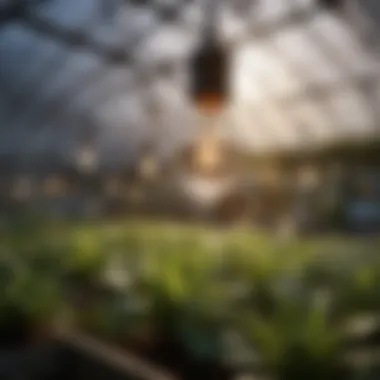Halide Light Bulbs in Agriculture: Features and Benefits


Intro
In the ever-evolving realm of agriculture, light plays a pivotal role, especially when we delve into the world of halide light bulbs. These somewhat underrated but highly effective light sources are instrumental in enhancing plant growth, particularly in controlled environments like greenhouses. Ever since the dawn of modern agriculture, the importance of proper lighting has been recognized, and halide bulbs have emerged as one of the most reliable options for farmers and horticulturists alike.
Understanding the nuances of halide light bulbs goes beyond just their technical features. It invites an exploration of their unique applications, benefits, and the latest trends impacting agricultural landscapes. From boosting crop yields to ensuring that plants receive the right spectrum of light, these bulbs serve as vital tools in the hands of skilled growers. As we embark on this discussion, it becomes clear that dissecting the mechanics and applications of halide bulbs unveils a treasure trove of insights beneficial to anyone keen on the modern agricultural journey.
Intro to Halide Light Bulbs
Understanding halide light bulbs is crucial in modern agriculture, where efficient lighting can significantly influence plant growth and productivity. As farmers seek to maximize yields and enhance the quality of crops, the right lighting solutions become paramount. Halide light bulbs are an often-overlooked yet vital piece of this puzzle, serving as an essential tool in both indoor and greenhouse farming setups.
Definition and Overview
Halide light bulbs primarily belong to two categories: metal halide and high-pressure sodium bulbs. Both types operate on a similar principle. They use a gas mixture that, when electrified, produces light. This is particularly potent when wavelength specificity is crucial, as it affects photosynthesis and plant growth cycles.
Metal halide bulbs emit a broad spectrum of light, providing the full visual spectrum that plants thrive on. Their ability to render white light with a high color rendering index is vital for growers who monitor plant health visually. Conversely, high-pressure sodium bulbs tend to emit a yellow-orange light, which promotes flowering and fruiting. This quality makes them ideal for certain stages of plant development.
Understanding these definitions lays a simple groundwork for recognizing the complexities associated with these technologies.
Historical Context
The journey of halide bulbs in agriculture traces back to the early days of artificial lighting. The 1960s marked notable advancements in lighting technologies, allowing for the integration of halide bulbs into agricultural practices. Over the decades, these bulbs gained popularity among horticulturists seeking ways to extend growing seasons and improve crop yields.
"As agriculture stepped into the age of technology, lighting became not just an afterthought but a cornerstone of modern farming techniques."
This evolution from traditional daylight reliance to artificial lighting showcases a remarkable shift in agricultural paradigms. Initially, it was perhaps a novel concept; however, it eventually thrived into an essential practice, particularly with the rise of greenhouse farming.
Farmers learned through trial and error that manipulating light conditions could yield higher quality and quantity of produce. As various halide bulb technologies emerged and developed, insights into their spectral outputs began to guide more tailored applications. This historical perspective illustrates how critical these inventions are to today’s agricultural success.
Understanding the Science Behind Halide Bulbs
Understanding how halide bulbs operate is pivotal in appreciating their application in agriculture. Without grasping the fundamentals of this technology, farmers and horticulturalists may miss out on optimally utilizing their benefits, which are crucial for successful crop growth and resilience. Halide bulbs stand out in their ability to emit a spectrum of light favorable for plant health, and knowing the nuances of how these bulbs function can inform better decisions in lighting setups.
How Halide Bulbs Function
Halide bulbs, when electrified, produce light through a unique process involving gas and metal salts sealed within a quartz envelope. Their operation hinges on the ionization of gas and metal compounds when electricity passes through them. Once ignited, these bulbs emit a bright light containing wavelengths that plants respond to more efficiently than others.
The structure of halide bulbs plays a role here. The construction ensures that essential elements like sodium, mercury, and various halides are heated up to a point where they vaporize, generating intense illumination. The light from these bulbs can mimic the sun’s natural spectrum, thereby fostering photosynthesis effectively. This imitation of sunlight is what makes halide bulbs indispensable in agriculture, particularly for those growing plants in controlled environments.
Types of Halide Bulbs
When speaking of halide bulbs, it’s important to know not simply what they are but also the different types available. The two prominent kinds frequently discussed in agricultural applications are High-Pressure Sodium bulbs and Metal Halide bulbs. Each has its distinct characteristics and roles that can suit various agricultural needs.
High-Pressure Sodium Bulbs
High-Pressure Sodium bulbs are a cornerstone in agricultural lighting. They tend to emit a warm, yellow-orange light that is appealing both in aesthetics and functionality. One key characteristic of these bulbs is their energy efficiency. They convert a significant amount of electricity into usable light, which translates into lower energy costs for farmers. Additionally, they generate intense light that can penetrate dense foliage, making them a popular choice for various crops that require robust light exposure.
However, they do have their downsides. The spectral output leans heavily towards the yellow and red spectrum, which may not provide a balanced light quality optimal for all plant types. Some growers find themselves supplementing these bulbs with others to ensure a full spectrum is attained.
Metal Halide Bulbs


On the flip side, we have Metal Halide bulbs. These bulbs shine brightest in their ability to deliver a more balanced spectral output compared to their High-Pressure Sodium counterparts. The light tends to be cooler and whiter, which better encompasses the blue spectrum. This feature supports the vegetative phase of plant growth, encouraging strong development of leaves and stems. In essence, Metal Halide bulbs are often lauded for enhancing color reproduction—they allow plants to exhibit their true colors under light, which can be essential for growers aiming for specific tones in their produce.
Despite their advantages, Metal Halide bulbs have their limitations. They use more electricity and have shorter lifespans compared to High-Pressure Sodium bulbs, which can lead to frequent replacements and increased costs over time.
Comparison Between Types
Ultimately, the comparison between High-Pressure Sodium and Metal Halide bulbs revolves around their suitability for different stages of plant growth. High-Pressure Sodium bulbs excel in fruiting and flowering stages due to their light intensity and energy efficiency. Conversely, Metal Halide bulbs shine brightly during the vegetative stage, favoring crops that require ample light in a spectrum that supports foliage.
Role of Light Quality in Plant Growth
Light quality plays a pivotal role in the growth and development of plants. It's not just the sheer brightness of the light that matters, but also the wavelengths and intensity associated with it. Different light spectrums influence various biological processes in plants, from photosynthesis to flowering, underscoring the importance of tailored lighting solutions in agriculture.
When we talk about light quality, we are essentially referring to the composition of light that plants receive. This includes the spectral output, which encompasses the specific wavelengths emitted by the light source. In horticulture, many growers have noticed that certain light wavelengths can trigger specific responses in plants. For instance, blue light is known to promote vegetative growth, while red light is mainly responsible for flowering and fruiting. This understanding helps farmers tailor their lighting systems to enhance the overall yield and quality of their crops.
The choices around light quality also involve managing the duration of exposure. Photoperiodism, where plants respond to the length of day and night, heavily affects flowering cycles in many species. For example, some plants only bloom when nights are short, while others need extended darkness. Farmers who are aware of these light quality specifics can control environments—especially in greenhouse settings—to optimize plant health.
Moreover, light quality is tied to energy efficiency. Employing the correct type of light can minimize wastage of energy, which is a concern for agricultural producers aiming for sustainability. To maximize productivity without compromising the environment, understanding the delicate relationship between your plants and their light source becomes essential.
"Light is the essence of life; without it, no green thumb can last."
The challenge lies in balancing these varied aspects of light quality while being mindful of the specific needs of each crop. Utilizing halide bulbs that offer tailored spectral outputs stands as a smart solution to these demands. Educating oneself on the wavelength responses of plants can turn a good grow season into a great one, providing both robust plants and sustainable practices.
Spectral Output and Plant Response
The spectral output of light sources refers to the range of wavelengths that light emits. Each color in the light spectrum serves a unique purpose in plant biology. Blue light (400-500 nm) has been shown to enhance chlorophyll production, which is vital for photosynthesis. Plants exposed to this spectrum tend to develop strong stems and vibrant leaves. On the other hand, red light (600-700 nm) promotes flowering and fruit production.
But it doesn't stop there—there's also an emerging understanding that far-red light plays a crucial role in regulating plant behavior. This can lead to a better understanding on how to manipulate flowering times, especially in crops where timing is pivotal for maximizing market value.
To take advantage of this, growers can employ a combination of halide bulbs to achieve a full spectrum of light that meets these diverse needs. Some systems even utilize sensors to adjust light output based on real-time feedback from plants, facilitating a direct response to plant requirements.
Light Intensity and Duration
Light intensity refers to the amount of light that reaches the plants, so it becomes another critical aspect of cultivating healthy crops. Different plants have varying tolerance levels and requirements for light intensity. For instance, succulents might thrive in higher light environments compared to shade-loving ferns.
Duration, or photoperiod, adds another layer of complexity. If plants receive insufficient light duration, they may struggle to photosynthesize efficiently, ultimately stunting their growth. Alternatively, prolonged exposure can lead to stress or imbalanced growth patterns.
When using halide bulbs, farmers should experiment with different intensities and durations. Setting up a light regimen tailored to the specific needs of each crop can substantially boost productivity.
For example, employing a 12-hour photoperiod for leafy greens while observing a 16-hour photoperiod for flowering plants can create optimized conditions for plant growth. A thoughtful synthesis of both intensity and duration can set the stage for successful cultivation, ensuring crops achieve their maximum potential.
Applications of Halide Bulbs in Agriculture
The use of halide light bulbs in agriculture presents a fascinating narrative that reflects the convergence of technology and nature. In the field of agriculture, deploying the right lighting technology is crucial for maximizing productivity and ensuring the quality of crops. Halide bulbs have carved a niche for themselves in this context, offering unique advantages that cater specifically to the needs of farmers and horticulturists.
Greenhouse Lighting
Greenhouses rely heavily on managed environmental conditions to promote optimal growth rates. The key to achieving this is through effective lighting, which is why halide light bulbs are favored. These bulbs emit a spectrum of light that closely mimics sunlight, which is essential for photosynthesis. By optimizing light exposure, plants are more likely to thrive and flourish.
Moreover, halide bulbs can significantly extend the growing season. In colder climates, where sunlight is limited during winter months, these bulbs can supplement natural light, allowing farmers to grow crops year-round. This ability to manipulate light duration and intensity translates directly to increased productivity and expanded options for crop rotation.


Indoor Cultivation
Indoor farming is becoming increasingly popular for various reasons, ranging from urban agriculture to maximizing yield in confined spaces. Halide bulbs provide the intensity and quality of light necessary to grow plants effectively indoors. They not only improve the germination rates but also enhance the overall health of the plants by providing the right wavelengths needed for optimal growth.
Additionally, the ability of halide bulbs to penetrate deeper into foliage means that they can support plant varieties that typically require stronger light. The adaptability of these bulbs allows urban farmers to cultivate a wide range of crops, from leafy greens to flowering plants, making them an integral part of modern agricultural practices.
Impact on Crop Yield
The bottom line for any farmer is productivity. Halide light bulbs have been shown to have a significant impact on crop yields. By providing the correct light conditions, they enable photosynthesis to occur at its peak potential, resulting in faster growth rates and healthier plants.
- Higher Quality Produce: Halide bulbs enhance the color and flavor of fruits and vegetables, making them more appealing in the marketplace.
- Consistent Yield: The controlled lighting environment helps in achieving uniform crop development, thus allowing for more consistent harvests.
- Resource Optimization: By tailoring light exposure to specific growth phases, farmers can reduce resource waste while enhancing yields, which is a win-win for both the economy and the environment.
"The adoption of halide bulbs in agriculture is not merely a technical upgrade; it reflects a deeper understanding of how light influences plant biology."
Through these applications, it’s clear that halide bulbs play critical roles in the future of agriculture, bridging gaps between technology and traditional farming methods.
Benefits of Halide Bulbs in Horticulture
The application of halide light bulbs in horticulture is not just a matter of convenience; it addresses some fundamental challenges faced by growers today. With the right lighting technology, cultivation becomes an art form, and these bulbs have changed the game substantially. Their unique features lend themselves to various forms of agricultural practices, enhancing growth potential, maximizing yield, and creating an optimally productive environment.
Energy Efficiency
Energy efficiency is probably the cornerstone of halide bulb technology. Farmers today are facing rising energy costs, making it imperative to invest in lighting that won't drain the budget. Halide bulbs are renowned for their ability to produce significant illumination while consuming less energy compared to traditional incandescent lights.
- They use a mixture of gases inside the bulb that ignite and produce light without much heat.
- This energy-efficient characteristic means that they convert a high percentage of the input power to usable light, thereby allowing for longer usage with lower power bills.
Moreover, many growers have reported seeing a reduction in their overall energy consumption after switching to these bulbs. This not only has an impact on immediate cost but also on the carbon footprint of agricultural practices.
Long Lifespan and Durability
Another crucial aspect of halide lighting is its longevity. Unlike conventional options that may burn out after a few months, halide bulbs frequently last much longer—often years. Their robust design withstands the changing environment typical of greenhouses and grow rooms, meaning less hassle for growers.
- The durability is not just about longevity; halide bulbs resist common issues such as filament breakage. This leads to less frequent replacements, which means reduced labor costs and less downtime in operations.
- In challenging environments, where temperature and humidity fluctuate, halide bulbs continue to shine brightly, ensuring that plants receive the consistent light they need.
With lower replacement frequency, not only do farmers save on costs, but they also contribute to less waste, supporting sustainability efforts in agriculture.
Enhanced Color Rendering
Halide bulbs stand out because of their enhanced color rendering capabilities. For plants to thrive, they need more than just light; they require light in the right spectrum. Halide bulbs emit a balanced spectrum that closely resembles natural sunlight. This feature is pivotal for plant photosynthesis and overall growth.
- Different crops benefit from specific wavelengths of light, and halide bulbs provide an effective range that promotes various growth stages. Notably, they assist flowering plants in their blooming processes by offering an adequate spectrum during crucial development phases.
- Additionally, the quality of light provided helps in bringing out the vibrant colors of certain crops. Investors and market growers alike appreciate this, as the visual appeal can greatly affect marketability.
"The right light can mean the difference between a bountiful harvest and a lackluster yield."
Challenges Associated with Halide Bulbs
In the realm of agricultural technology, halide light bulbs are recognized for their significant role in enhancing plant growth and productivity. However, their utilization is not devoid of challenges. Addressing these challenges is paramount for farmers and horticulturists to make informed decisions that maximize benefits while minimizing drawbacks. Here, we explore the two main pressing challenges associated with halide bulbs: heat generation and environmental concerns.
Heat Generation and Management


Heat generation is a well-known issue with halide bulbs, and it’s something every grower needs to consider. These bulbs produce a considerable amount of heat during operation, which can pose risks to both plants and equipment.
When plants are exposed to excessive heat, they can suffer from heat stress, leading to wilting or even death. Thus, effective heat management becomes crucial. Growers may need to invest in additional cooling systems such as fans or air conditioning units to manage temperatures within optimal ranges. This not only increases operational costs but also complicates the setup.
For instance, a greenhouse that integrates halide lighting must have a well-planned ventilation system to mitigate the heat, ensuring the longevity and vitality of the crops inside.
In addition to cooling systems, growers can consider alternative mounting options or reflective surfaces to distribute heat more evenly, minimizing hot spots where plants may be more prone to damage. Finding a balance between lighting and temperature is key to successful crop production.
Environmental Concerns
The use of halide light bulbs comes with a laundry list of environmental issues. While these bulbs can promote plant growth, their production and disposal processes can significantly impact the environment.
Firstly, halide bulbs contain materials that may be hazardous. When disposed of improperly, these components can leak into the soil and water supply, adversely affecting ecosystems. Responsible disposal is critical—farmers should engage with local recycling programs that handle such materials safely, thus lessening their ecological footprint.
Moreover, the energy consumption of halide bulbs has raised eyebrows among environmental advocates. While they are more efficient than incandescent bulbs, their energy usage is still higher compared to newer technologies like LED lights. The push for sustainable farming practices brings this concern to the forefront, urging agriculturalists to weigh the benefits of halide technology against its environmental impact.
Balancing crop yield and environmental sustainability is no easy feat, but an essential strategy moving forward. As growers become more aware of sustainability issues, they may explore alternative lighting solutions or practices that reduce overall reliance on energy-intensive halide bulbs.
One must remember that every bulb shines light, but the cost to the environment is a shadow we should not overlook.
Innovations and Future Trends in Lighting Technology
The world of agricultural lighting is undergoing a significant transformation. Innovations in lighting technology, particularly regarding halide bulbs, have become a focal point for farmers and horticulturists striving to enhance productivity and sustainability. Understanding these developments can provide insights into how they impact both crop yields and energy consumption.
One of the most exciting developments is the leap toward LED technology advancements. Unlike traditional halide bulbs, LEDs offer a multitude of benefits. They produce much less heat, thus reducing the energy wasted in generating warmth. This also means that the cooling systems can be less complex, which is a boon for farmers operating in hot climates. Additionally, LEDs can be tailored to emit specific wavelengths that are best absorbed by plants, drastically improving photosynthesis and growth rates.
LED Technology Advancements
LEDs have taken the agricultural lighting scene by storm. With their capacity for fine-tuning light spectra, they enable more efficient growth in a variety of crops. The ability to provide blue light during the vegetative stage and red light during flowering is a game-changer.
- Energy Efficiency: LEDs use significantly less power per lumen produced compared to halide bulbs. In essence, they offer a threefold boost in efficiency.
- Long Lifespan: While metal halide bulbs can falter after 10,000 hours, LEDs can last up to 50,000 hours or more, reducing replacement costs for growers.
- Low Heat Production: This characteristic allows farmers to position lights closer to the plants, maximizing the use of light without risking damage from heat.
- Uniform Light Distribution: Unlike halide bulbs which can have hot spots, LEDs offer even light spread, promoting better growth throughout the canopy.
Even though LEDs are making strides, the historical reliance on halide bulbs remains; hybrid systems incorporating both could be a middle-ground that combines the best of both worlds for specific applications.
Integration with Smart Farming Solutions
The integration of lighting technology with smart farming solutions is also paving the way for a new era in agriculture. This marriage of technology not only enhances crop growth but also allows farmers to engage in data-driven decision-making.
Smart farming solutions involve using sensors and IoT devices to gather data on plant needs. When combined with advanced lighting systems, farmers can tailor the light conditions to match the specific growth cycles of their crops.
- Automated Systems: This allows for lights to be adjusted in real-time based on weather conditions, plant growth stages, and other external factors. Automation enhances efficiency and optimizes resource usage.
- Remote Monitoring: Farmers can manage lighting conditions via smartphones or computers, enabling them to control their crops' environment from anywhere.
- Data Analysis: Collecting data helps in analyzing growth patterns and improving overall farm management. Recognizing trends and patterns can lead to enhanced strategies for crop production.
End
Wrapping things up, the exploration of halide light bulbs reveals just how critical they are for modern agriculture. They are not just mere sources of light; they offer a lifeline to farmers and growers who seek to enhance their crop yields and quality. As we have seen through various sections, these bulbs play a substantial role in influencing plant growth, specifically through their spectral output, which affects photosynthesis and overall plant health.
Summary of Key Points
- Functionality: Halide bulbs work by producing light across a spectrum that is beneficial for plant growth. This versatility is key in varying agricultural setups such as greenhouses and indoor facilities.
- Types: Different types of halide bulbs, like high-pressure sodium and metal halide, bring unique advantages to specific scenarios. Each type has its place in agriculture, whether it be for flower production or leafy greens.
- Benefits in Horticulture: Their long lifespan and energy efficiency make them appealing choices for growers looking to manage costs while ensuring optimal growing conditions.
- Challenges: While there are considerable advantages, heat generation and environmental concerns cannot just be pushed aside. Efficient management strategies need to be developed to overcome these hurdles.
- Future Trends: Emerging technologies such as LED integrations and smart farming applications indicate the further evolution of lighting solutions in agriculture.
Final Thoughts on Halide Bulbs' Role in Agriculture
In summation, the role that halide light bulbs play in agriculture is akin to a sturdy backbone supporting various farming methods. With the ability to boost photosynthesis and extend growing seasons, their impact is deep and far-reaching. Farmers and horticulturists, whether they are tending to a small plot or managing large-scale operations, need to consider these bulbs in their lighting arsenal.
Moreover, as the agricultural landscape continues to evolve, the synergy between halide technologies and new advancements in smart farming could lead to even greater efficiencies. By understanding and leveraging the benefits and challenges of halide bulbs, agriculture professionals can better position themselves to meet the growing demands of food production, ensuring a sustainable future for both the industry and the environment.







